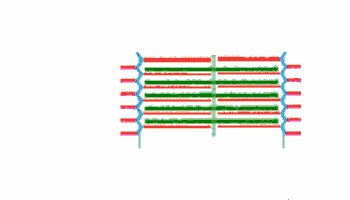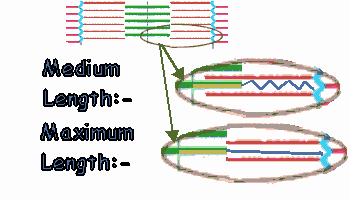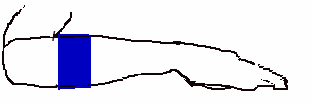
(C) When the wrist and forearm is at OBP during use, the muscles are
at their most capable to deal with "shock wave" or "jarring".
At its comfortable "OBP" middle range, the muscle is best able to absorb
(for example) the "jarring" or "shock" wave, that would be
generated by a backhand tennis volley, or by hammering.
Compare these three muscle length scenarios:
|
(1) Short muscle:
The Actin and Myosin filaments fully overlap, such that the shock
wave carrying medium (the sarcomere) is of uniform density. A
medium of uniform density is the type of medium that most effectively
transmits a shock wave to the ECRB tendon on the side of the elbow. |
The muscle contractile unit (the sarcomere) at its shortest.
Green protein units: Myosin; Red protein units: Actin
 |
(2) Medium Length muscle:
The actin and myosin filaments only half overlap, presenting a none
uniform medium to the shock wave. This presents a situation similar
to that of the lane marker ropes in an Olympic swimming pool: The
ropes make the surface of the water "none uniform" and (certainly
desirable for the competitors!) break a single wave up into a number of smaller
waves heading in different directions. In this scenario, the single large shock
wave that the sarcomere transmits is broken up into a number of smaller,
less deadly shock waves. The ECRB tendon therefore has less shock wave loading. |
The muscle contractile unit (the sarcomere) at its middle length.
Green protein units: Myosin; Red protein units: Actin
 |
(3) Maximum length muscle:
The actin and myosin filaments do not overlap, and in fact are not
particularly strong to carry any sort of shock loading. The Titin
protein elements that run alongside the actin/myosin proteins
transmit the shock wave instead. Because they run the length of
the half sarcomere, they constitute a uniform medium, but
they behave more like a rubber band (ie. they stretch a little and snap back).
The process of stretching and
returning to pre-shock wave length absorbs the shock wave energy, thereby protecting the ECRB tendon,
but does put the muscle body at risk of tearing.
|
The muscle contractile unit (the sarcomere) at its medium and maximum length.
Green protein units: Myosin; Red protein units: Actin;
Yellow and purple protein unit: Titin. Note the "spring like" coiling
of the purple part of the titin protein*.

*A grossly oversimplified description of this fascinating muscle protein.
Try the following references:-
Titin Reference 1
Titin Reference 2
|
| "Get to Know your Forearm" Exercise 4: Jarring the ECRB muscle.
Proceed with caution! Jarring a painful "Tennis Elbow" is
not recommended! Only try this on a healthy forearm!
|
|---|
1 Clench your fist, and put your wrist in its mid range of flexion.
Now hit the back of the clenched fist with your other (clenched) hand. Repeat ten
times, and note where the discomfort lies in the system. Note how
little wrist movement there was at the moment of strike! The muscles are strong in this position!
Chances are the forearm muscles will feel the strain, but
that there is no major discomfort after the jarring. |
Wrist in "OBP" , ECRB muscle at its middle length).
 |
2 Clench your fist, and this time extend your wrist
(puts the ECRB muscle at its
shortest length), and tense the forearm! Now hit the back of the clenched fist
with your other (clenched) hand. Again, note how little movement there was at
the moment of strike! Repeat five to ten times, and feel where the discomfort
lies in the system. The jarring shock wave has efficiently transmitted up the
muscle to the tendon. Chances are the upper (proximal) end of the forearm muscles
and the outside of the elbow will ache after this less than ideal wrist positioning. |
Wrist in full extension: ECRB muscle at its shortest.
 |
3 Clench your fist, but this time put your wrist into full flexion. Now hit the
back of the clenched fist with your other (clenched) hand - not too hard! .
This time, you will notice a "bounce" as the tritin units in your muscle respond
in spring fashion. Note where the discomfort lies in the muscle and tendinous system.
Chances are, this time it's in the body or lower (distal) part of the muscle. |
Wrist in full flexion. ECRB muscle at its longest.
 |
Author's Note: The above discussion on jarring and muscle length applies not just to Tennis Elbow, but also to
many painful conditions. A few of them are listed here:-
- Golfer's elbow
- Shin splints
- Shortened Pyriformis syndrome
- Lengthened Pyriformis syndrome
- Posterior Gluteus Medius strain
- Anterior Gluteus Medius/Gluteus minimus strain
- (So called) Ischiogluteal bursitis/short hamstrings
- Latteral knee pain due to tight Tensor fascia lata- Ilitotibial band (TFL-ITB)
- Medial knee pain due to "Pes Inserinum", or tight medial hamstring
- Back pain due to lumbar lordosis and/or sway back
Damage via shock wave transmission through muscles that are outside of OBP applies to
all the above conditions.
|
OBP cures tennis elbow and other musculo-cutaneous conditions!
|
(D) When the wrist and forearm is at OBP during use, the muscles share the loading
more equally than they would at the extremes
of wrist and forearm positioning.
A load shared among tendons is less likely to damage a single tendon.
(E) Discussion of Other Therapies not necessarily related to OBP Theory
- Eccentric Resistance Training.
- That's where the sore muscle/tendon unit
gradually lengthens under load. This is the first type of "strengthening"
exercise you should perform (6). It is not just a strengthening exercise: It also
trains the ECRB muscle out of the habit of assuming its faulty DSM
when it is working. Note that this type of exercise may increase your tennis elbow discomfort,
so you need to start gentle.
-
Forearm Band:-
- Note the positioning of the armband over the widest part of the forearm:-

The armband must be firm enough not to slip, but not uncomfortably tight. It works like the capo placed over the strings
of a guitar. It dampens the jarring shockwave that travels up the forearm.
- Gentle Stretching (once acute pain is over).
- (Hard Stretching in my experience doesn't work: It just creates more damage and
pain at the already weakened ECRB tendon area, which in turn
creates more muscle splinting effect, which in turn creates more damage and pain!
Just don't do hard stretching!.
- Ultrasound
- Your physiotherapist is able to provide this treatment.
- Dry needling or Ischaemic Pressure of the "trigger point" in the muscle belly(More info...
The Triggerpoint Therapy Workbook...).
- Your physiotherapist is able to provide this treatment.
- Strapping
- Your physiotherapist is able to provide this treatment.
- Massage and brushing.
- Professional massage does bring relief.
- Sonoid massage. I have seen the Sonoid Massager in clinical application. It is
very effective in relaxing muscles in spasm. Refer
http://www.painmanagement.8m.com/.
- Self massage helps. I've found the following to be effective, though any gentle
self massage is likely to help.
- Apply "tickle" massage over the sore area and the tense muscle,
using the tips of the finger nails or a fine toothed metal flea comb at a 15 degree angle.
This will encourage the tight muscle to relax, thereby allowing the tendon to heal.
In my experience, 3 to 5 minutes of "tickle" massage will immediately
increase the dull ache of a tennis elbow, but
relaxation and easing of pain does follow and lasts a number of hours.
"Tickle" massage is related to brush massage techniques.
| OBP offers an entirely new approach to curing tennis elbow:
Try comparing what you have just learned with what is available online!- |
cures tennis elbow
|
|
OBP cures tennis elbow and other musculo-tendinous injuries!
|

Return to Top |
Proceed to page 4...
Pilates Online Printable Positions and Exercises with Pictures and Diagrams
© Bruce Thomson, EasyVigour Project

|
|
|
|